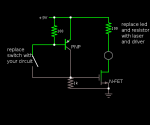Do you have a multimeter capabel of measuring mV (preferrably 0.1mV)?
What current does the DDL drivers need?
Do you have your 'oscilloscope' on your line-in working?
Then, know some basics of the design. An opamp is a differential amplifier. It amplifies the voltage between the input and output times a few million (clipped to the supply voltages). In other words (in this circuit) it outputs Vdd when pin 2 is lower than pin 3, and outputs Gnd when pin 2 is higher than pin 3. When the voltage on both pins is equal, the output floats somewhere in between to find a balance.
The output drives a transistor. This lets a current flow. This current also flows through the 1 Ohm resistor, creating a voltage relative to Gnd. This voltage is dependent on the drive for the transistor (but not entirely linear). Because this voltage is feed back to pin 2, the voltage on pin 2 is always equal to the current flowing through this resistor (and your DDL driver).
Combining these two situations, the situation exists where the voltage on pin 3 is always mimicked at pin 2. For that it has to have a current flowing through the resistor, for that it has to drive the transistor. In other words, the voltage given at pin 3 will drive the DDL with the same amount, but in mA.
So, when you want the DDL driver to accept X mA at maximum, and the optoisolator supplies Y Volts (probably close or equal to Vdd), then the voltage Y must be lowered to voltage X without loss of linearity. This is achieved with two resistors as a voltage divider (one is 180K plus the top part of the potmeter, and the other is the lower part of the potmeter). We assume the potmeter is in the middle ideally, and is turned only when calculations are off. The ratio of both resistors to the lower resistor is equal to ratio Y to X. The top resistor is then relative to Y-X. When the potmeter is 50K (for example) the lower part is 25K. When Y is nine times X, then the top part is (Y-X)/X = 8 times the lower part, so the top resistor should be 8x 25K = 200K. The real top resistor (without the other part of the 50K potmeter) is then 175K. (180K because 175K does not exist on the E24 scale) For other values, of X and Y this differs ofcourse. This is just an example.
Formal notation and simplified for ease of calculation:
Given:
- Rp = potmeter
- X = max DDL current, in Ampere (taken as Volts)
- Y = optoisolator voltage
Calculate:
- Rt = top resistor = ((Y/X-2)*Rp/2
Also do take a look at the specs of the optoisolator and change the 4.7K resistor to achieve the most effective.





